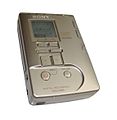Field recording
As field recording is called the recording of non-specifically generated sounds, natural sound events or of found soundscape outside a recording studios . In the narrower sense, what is meant here is, in particular, recordings of nature or ambient noises that are made with the help of portable recording devices. In the 20th century these were mostly analogue tape recorders , later cassette recorders . Today, digital devices are mostly used, such as voice recorders , laptops with an external operating device and suitable software, or dedicated field recorders. The field of field recording is closely related to technical phonography , so this term is sometimes used synonymously , based on photography . Field recordings differ from recordings in the studio mainly in the origin and nature of the sound material, the technology, the external conditions and the equipment.
history
The origin of field recording can be traced back to Thomas Edison's invention of the phonograph (1877). He originally developed the phonograph, also known as the speaking machine, to record speeches in the American Congress, court cases or business conferences and thus minimize tedious note-taking. Due to the further development of recording devices, especially the development of portable, high-quality devices, the field recording genre became more and more popular in the 20th century. Field recordings are also used today as a stylistic device in musical genres such as ambient , musique concrète and related directions. Furthermore, field recordings are used in particular in the areas of ethnology , music ethnology and bioacoustics .
Phonography focuses on the capture of sounds, regardless of how or by what means they were created. Originally the idea of documentation was in the foreground, but there were soon adaptations with aesthetic objectives, so that through manipulations and combinations of different recordings, sounds were created for film and radio, which were initially used in radio plays , then jingles and the like. Ä. were used as effects.
Field recording and soundscape have developed into independent forms of sound art . Some artists and labels focus on these areas. The work of Raymond Murray Schafer and his colleagues at the World Soundscape Project , such as Hildegard Westerkamp and Barry Truax (processed field recordings with granular synthesis ) in the 1970s and 80s, pioneered this.
Ethnomusicology

The means of field recording is one of the most important scientific tools in the field of ethnomusicology . The ethnomusicology examines music in a cultural and social context. Edison's invention of the phonograph made it possible for researchers to make sound recordings for the first time with the help of wax rollers and thus gave them the opportunity to examine the recorded material afterwards, etc.
German-speaking area
The founding of the Vienna and Berlin Phonogram Archives (1899/1900) went hand in hand with the emergence of comparative musicology . Carl Stumpf laid the foundation stone for the Berlin phonogram archive together with his student Otto Abraham , a Berlin gynecologist and music psychologist . Together they recorded the performance of an ensemble of Thai court musicians in 1900 with the help of an Edison phonograph. This recording was the cornerstone of the Berlin archive. It was the ethnologist Adolf Bastian who arranged for every German research traveler to be equipped with a phonograph. All of the material collected in this way went to the Berlin Phonogram Archive. The phonogram archive in Vienna was founded in 1899 by the neurologist Sigmund Exner , but the first recordings were not received until 1901.
United States
The zoologist , ethnologist and archaeologist Jesse Walter Fewkes (1850-1930) was the first to use the Edison phonograph for ethnographic recordings of music in the course of his research with the Passamaquoddy Indians (1890). His total of thirty recordings were entered into the National Recording Registry of the Library of Congress on January 27, 2003 because of their cultural and historical significance .
technology
Field recordings can be made with the aid of different recording devices. The simplest are portable digital recorders or voice recorders . They are usually equipped with stereo microphones , speakers and a headphone jack. Their compactness makes them easy to transport and quick and easy to use. In addition, recording devices with external microphones are often used, and a distinction is made between binaural and so-called MS stereo microphones in the field of stereo microphones . Also can addition of directional microphones , hydrophones or piezoelectric transducers are used. Common recording devices are CompactFlash , hard disk , MiniDisc or DAT compatible. However, higher quality digital dictation machines, notebooks with microphone input or analog cassette recorders can also be used. Transportable reel tape recorders were still popular until the 1980s, but have disappeared from the market.
Other accessories include headphones , wind / pop protection , shock mounts and microphone stands or tripods.
One of the first portable tape recorder from Philips , 1967
Portable mini tape recorder Kudelski Nagra Type III from 1967
The first Sony MiniDisc recorder, 1992
Professional stereo digital recorder from Nagra with exchangeable hard drive or CompactFlash memory card as storage medium, around 2002
Handy stereo PCM digital recorder in XY technology with up to 24 bit at 96 kHz, with internal memory and additional SD memory card , around 2009
literature
- Florian Carl: The beginnings of comparative musicology. In: Julio Mendívil, Oliver Seibt & Raimund Vogeld (eds.): Compendium Musikethnologie. Bärenreiter, Kassel.
- Maurice Mengel: Early American Ethnic Music and Franz Boas. No place, around 2010.
Web links
- Fieldrecording.de - online journal (German)
- Quiet American (English)
- The Field Reporter - Online Journal
- Field Notes - online magazine of the Gruenrekorder label (German / English)
Individual evidence
- ↑ Tobias Fischer: Political Sounds: Field Recording . Retrieved June 25, 2019 . (PDF; 208 kB) Article and interview with Lasse Marc Riek In: beat 05/2009
- ↑ Field Recordings by Jesse Walter Fewkes in the National Recording Library. Retrieved August 12, 2017 .









